1st Thessalonians and the Ministry of Paul - 2
Mike Ervin
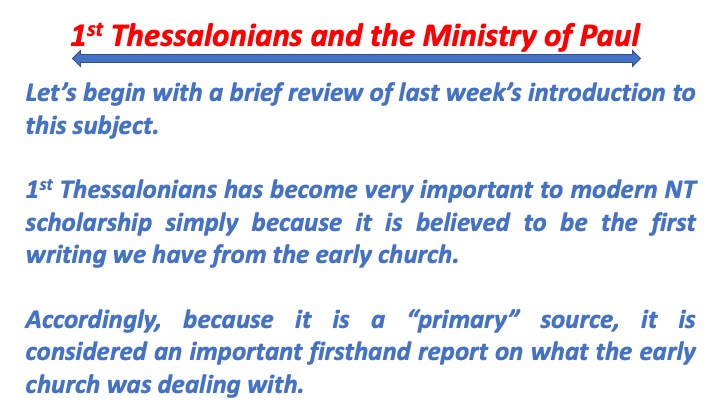
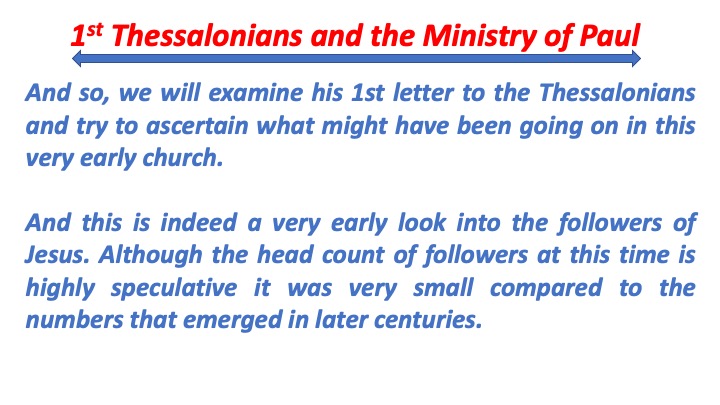
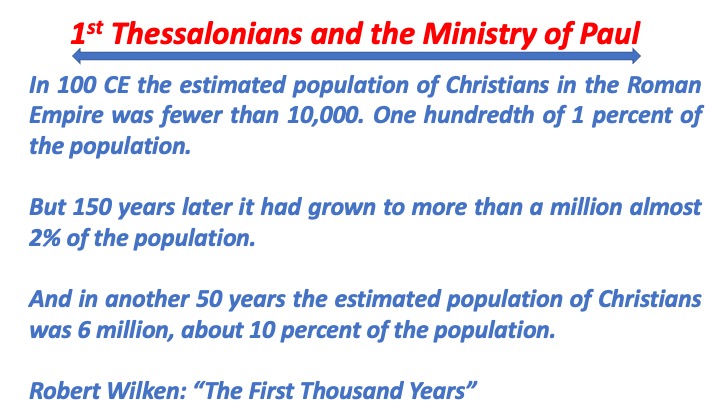
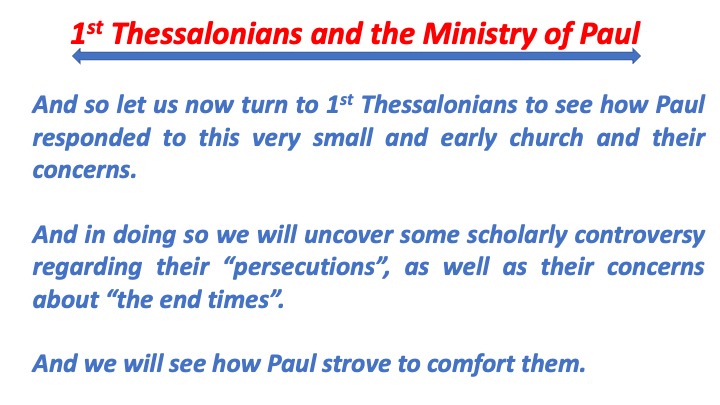
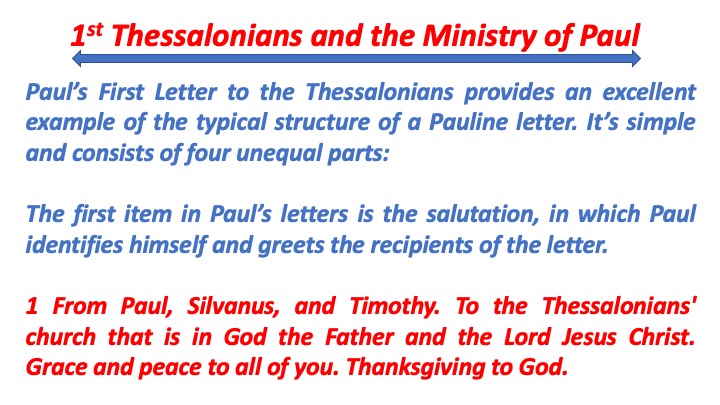
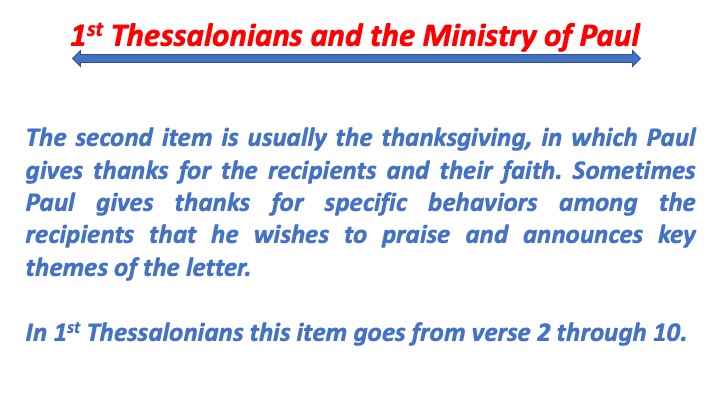
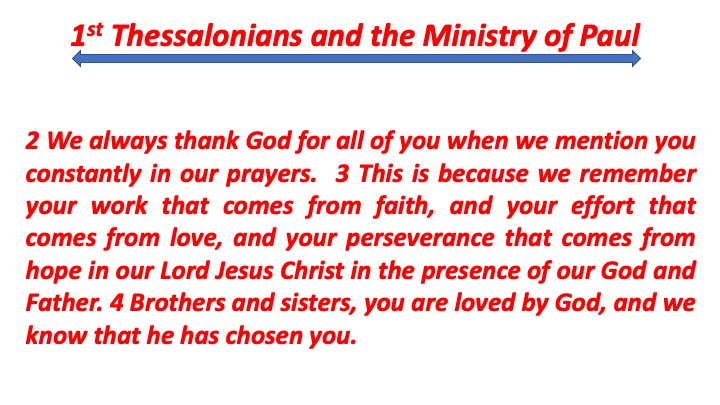
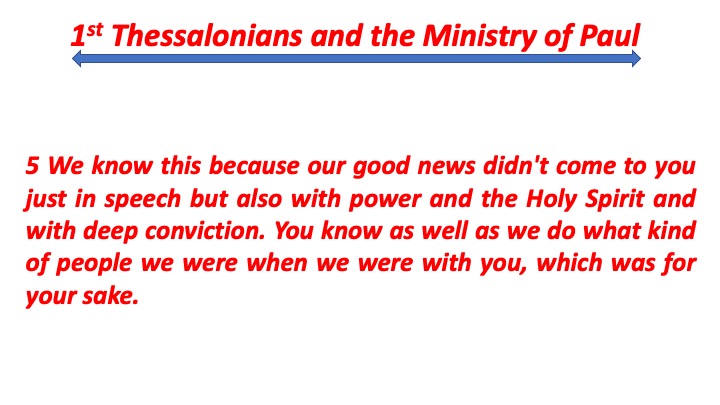
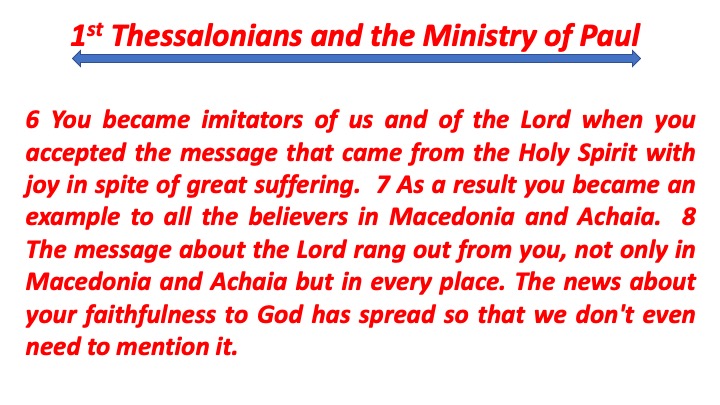
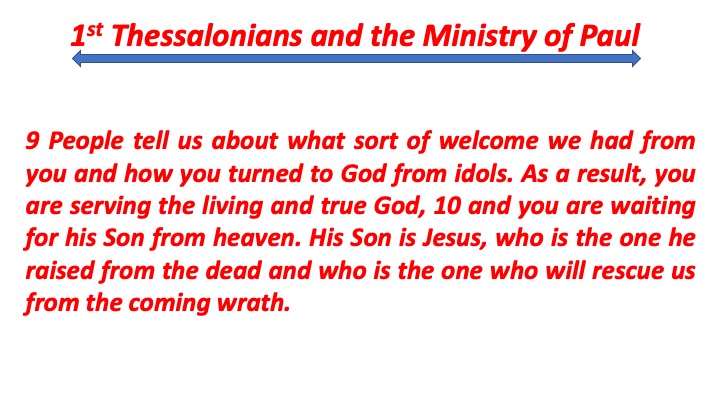
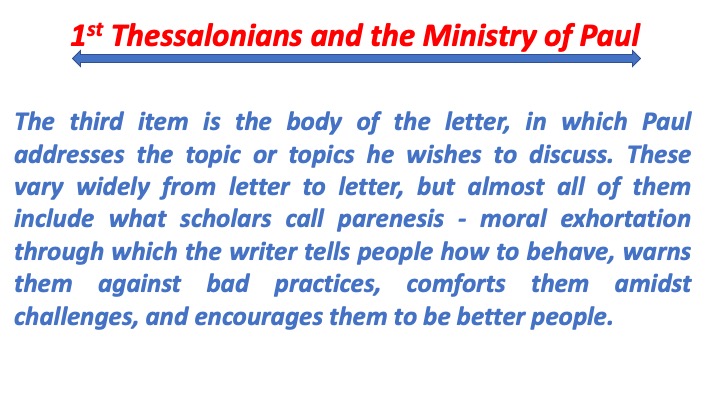
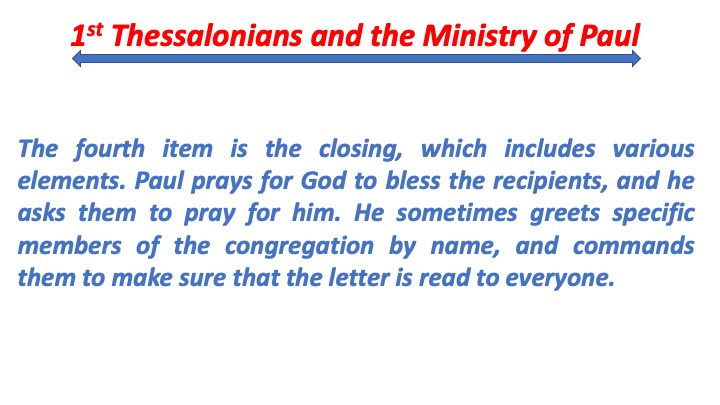
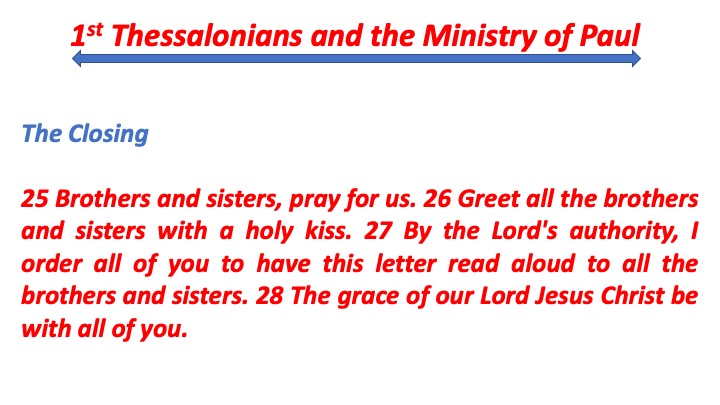
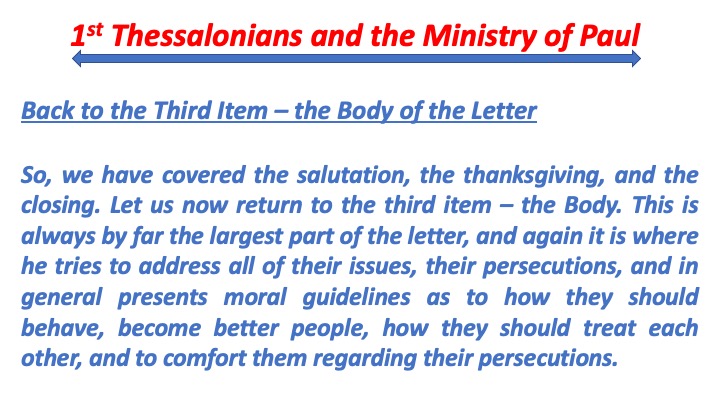
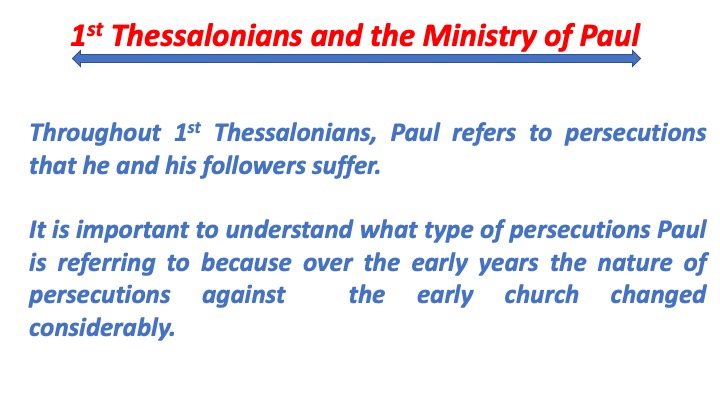
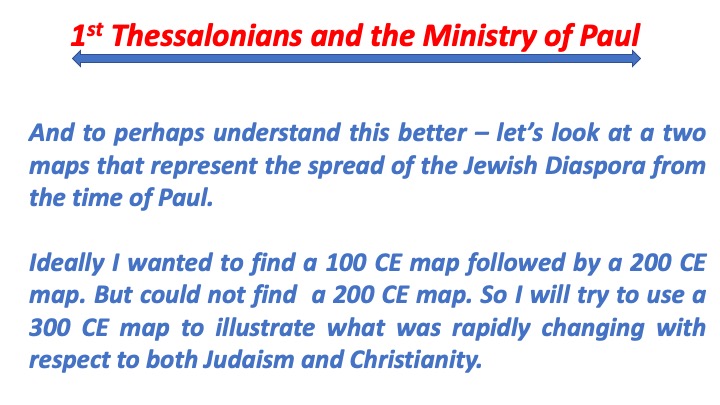
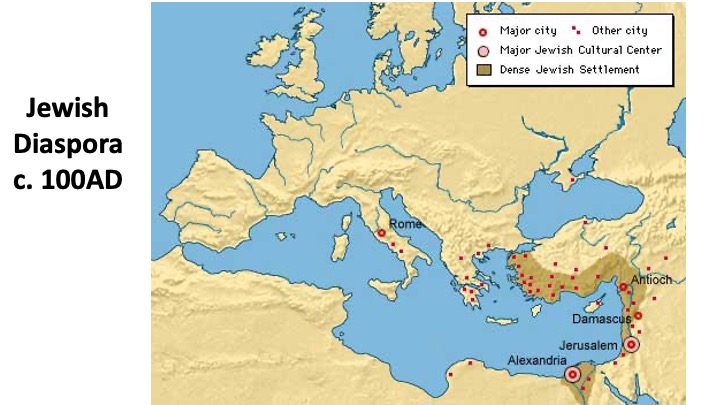
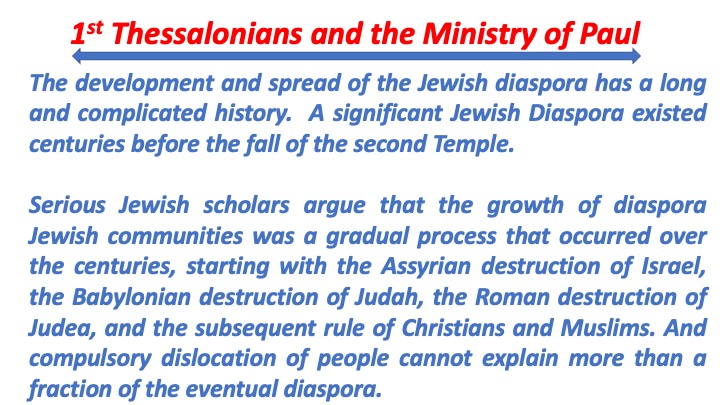
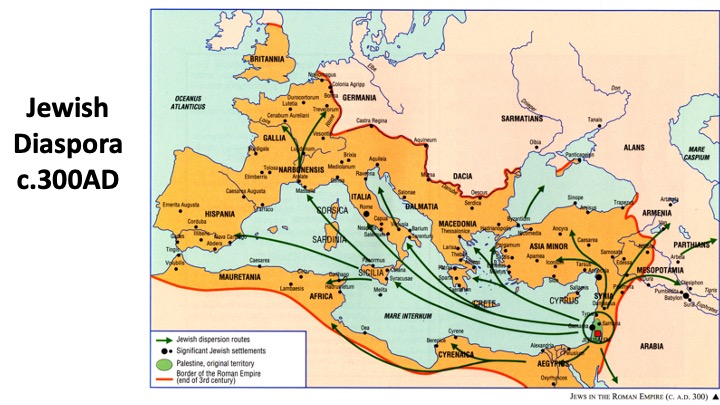
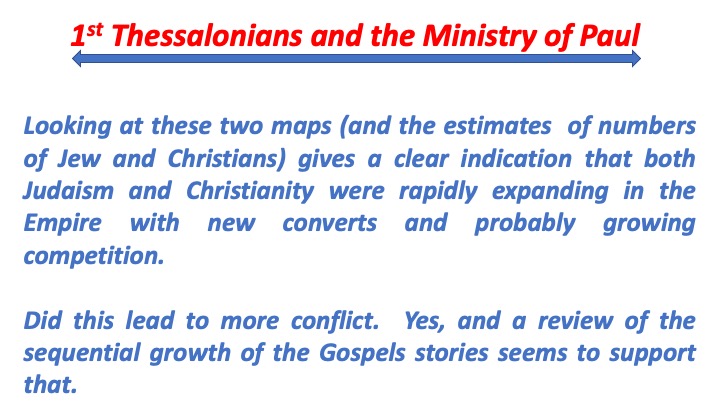
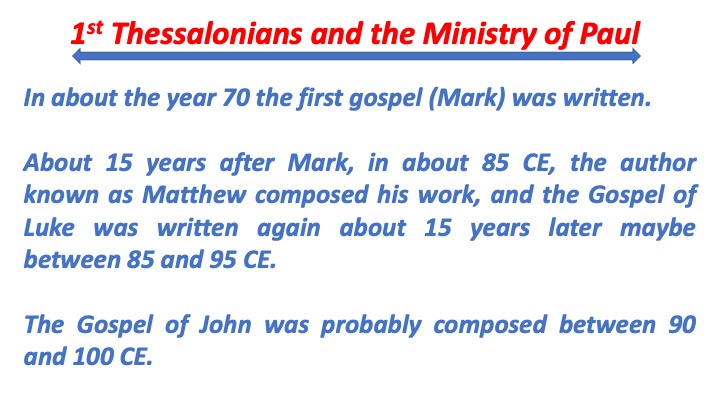
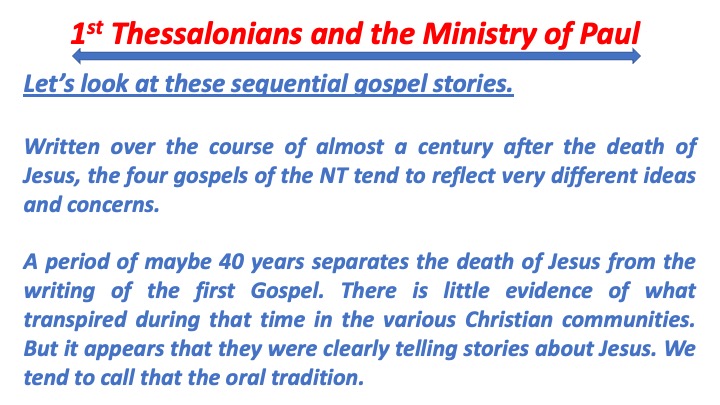
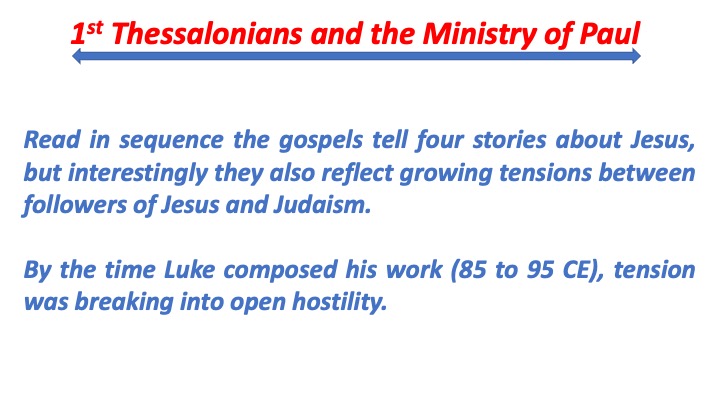
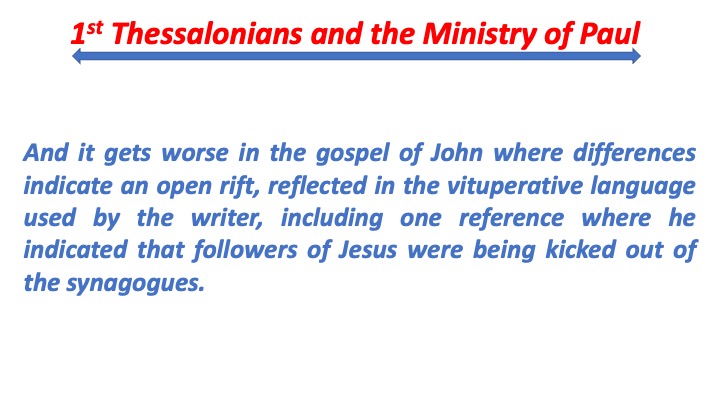
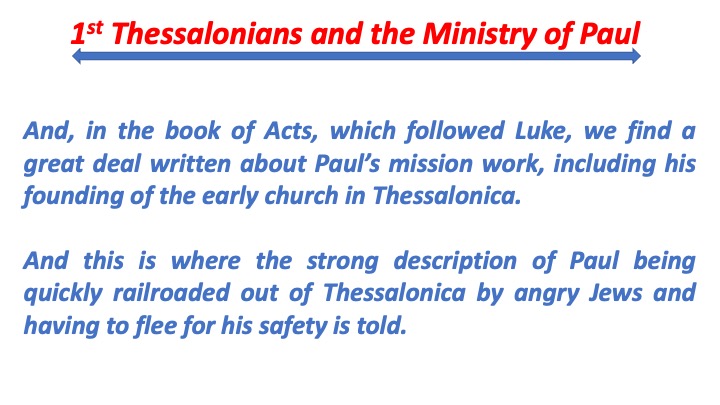
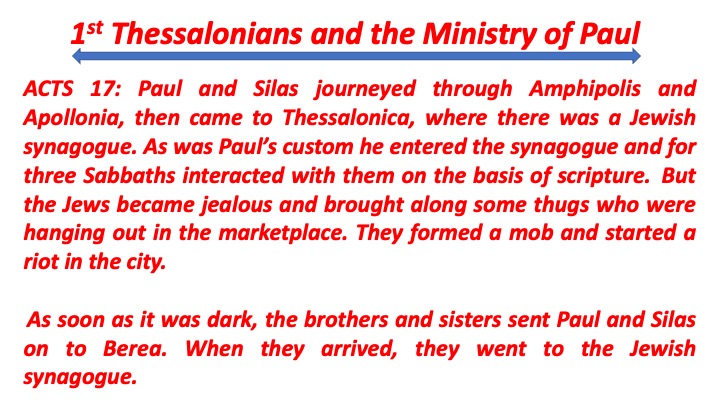
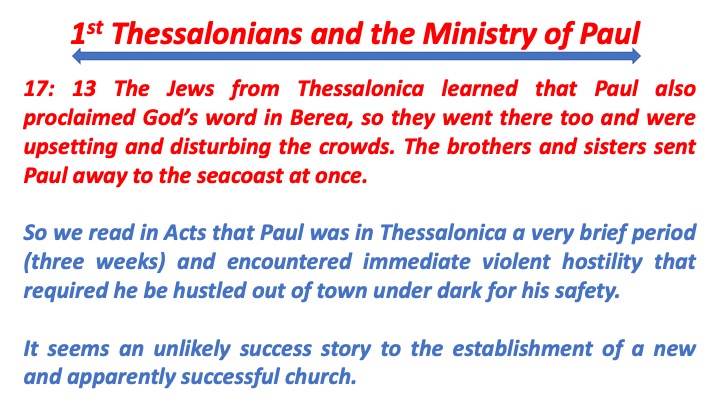
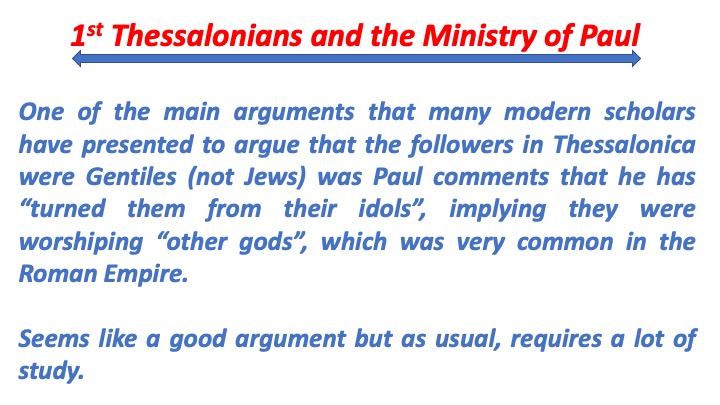
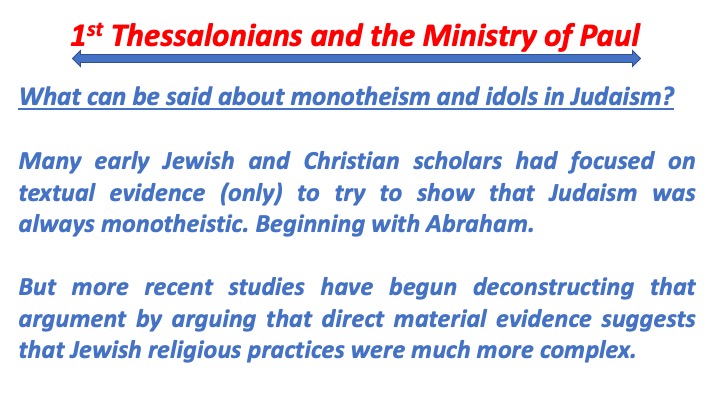
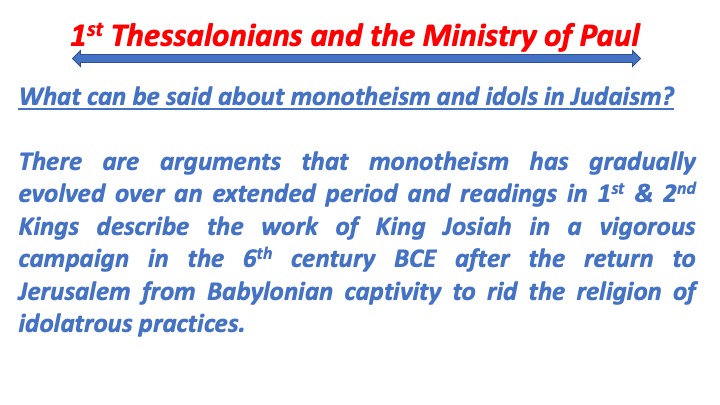
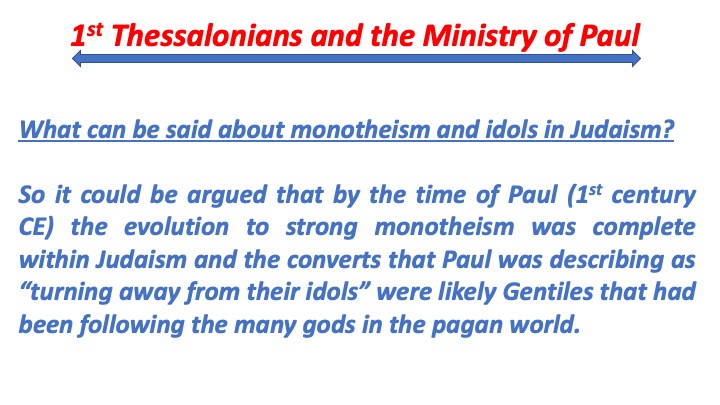
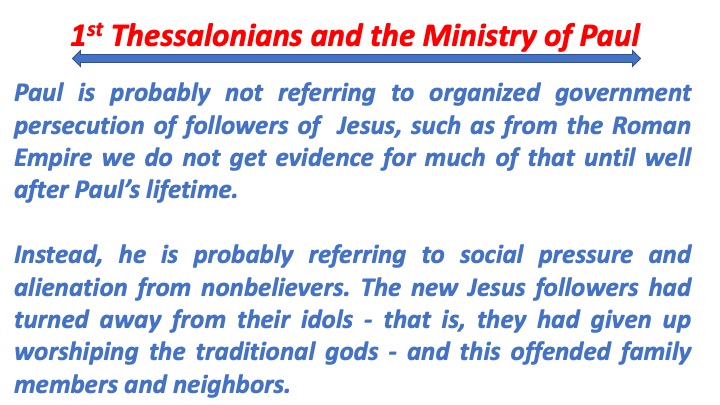
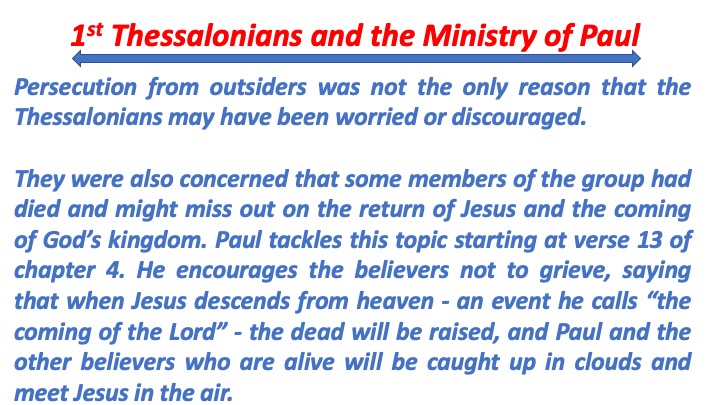
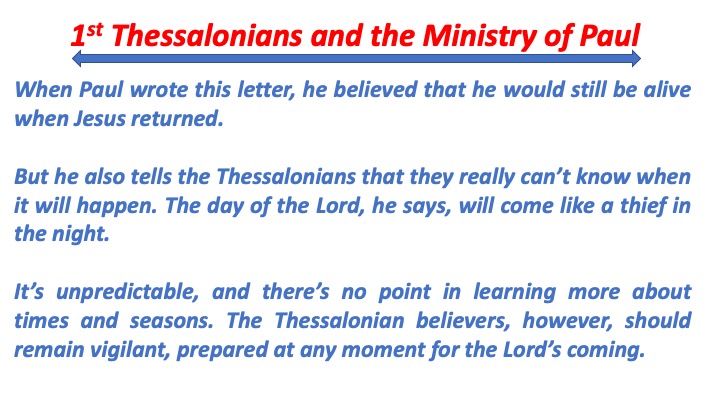
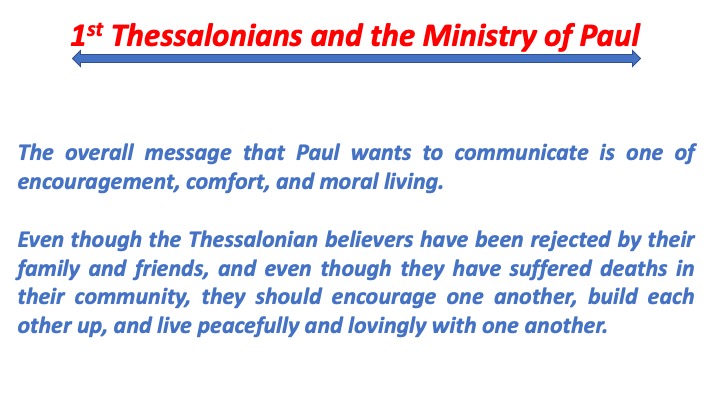
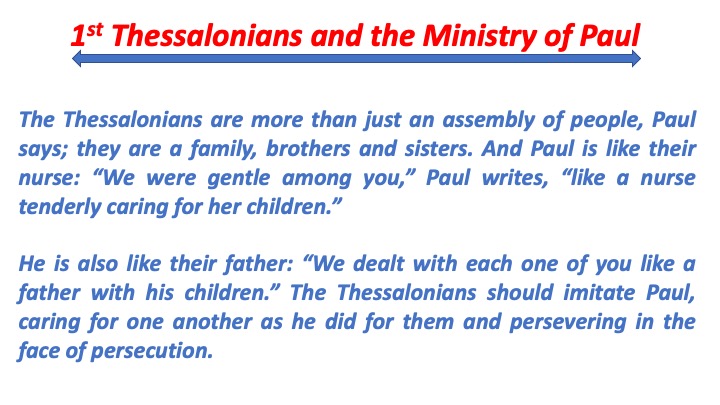
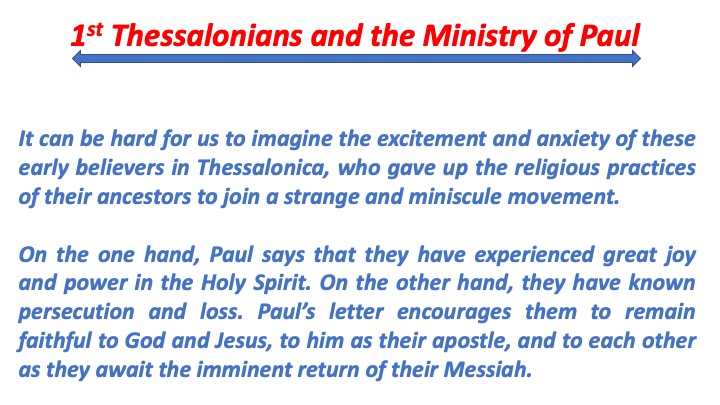
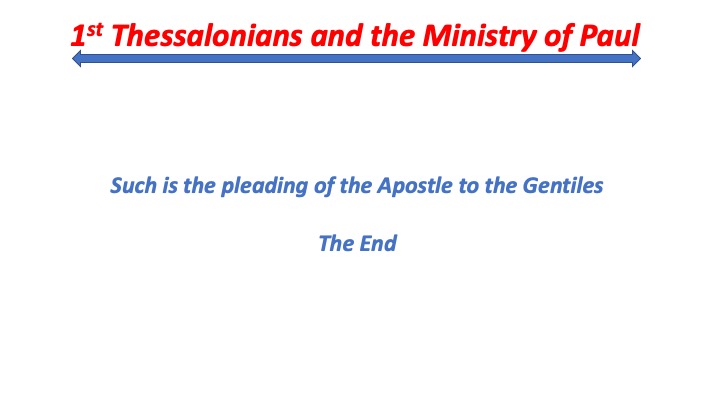
Text for Week 2
1st Thessalonians and the Ministry of Paul
Let’s begin with a brief review of last week’s introduction to this subject.
1st Thessalonians has become very important to modern NT scholarship simply because it is believed to be the first writing we have from the early church.
Accordingly, because it is a “primary” source, it is considered an important firsthand report on what the early church was dealing with.
1st Thessalonians and the Ministry of Paul
And so, we will examine his 1st letter to the Thessalonians and try to ascertain what might have been going on in this very early church.
And this is indeed a very early look into the followers of Jesus. Although the head count of followers at this time is highly speculative it was very small compared to the numbers that emerged in later centuries.
1st Thessalonians and the Ministry of Paul
In 100 CE the estimated population of Christians in the Roman Empire was fewer than 10,000. One hundredth of 1 percent of the population.
But 150 years later it had grown to more than a million almost 2% of the population.
And in another 50 years the estimated population of Christians was 6 million, about 10 percent of the population.
Robert Wilken: “The First Thousand Years”
1st Thessalonians and the Ministry of Paul
And so let us now turn to 1st Thessalonians to see how Paul responded to this very small and early church and their concerns.
And in doing so we will uncover some scholarly controversy regarding their “persecutions”, as well as their concerns about “the end times”.
And we will see how Paul strove to comfort them.
1st Thessalonians and the Ministry of Paul
Paul’s First Letter to the Thessalonians provides an excellent example of the typical structure of a Pauline letter. It’s simple and consists of four unequal parts:
The first item in Paul’s letters is the salutation, in which Paul identifies himself and greets the recipients of the letter.
1 From Paul, Silvanus, and Timothy. To the Thessalonians' church that is in God the Father and the Lord Jesus Christ. Grace and peace to all of you. Thanksgiving to God.
1st Thessalonians and the Ministry of Paul
The second item is usually the thanksgiving, in which Paul gives thanks for the recipients and their faith. Sometimes Paul gives thanks for specific behaviors among the recipients that he wishes to praise and announces key themes of the letter.
In 1st Thessalonians this item goes from verse 2 through 10.
1st Thessalonians and the Ministry of Paul
2 We always thank God for all of you when we mention you constantly in our prayers. 3 This is because we remember your work that comes from faith, and your effort that comes from love, and your perseverance that comes from hope in our Lord Jesus Christ in the presence of our God and Father. 4 Brothers and sisters, you are loved by God, and we know that he has chosen you.
1st Thessalonians and the Ministry of Paul
5 We know this because our good news didn't come to you just in speech but also with power and the Holy Spirit and with deep conviction. You know as well as we do what kind of people we were when we were with you, which was for your sake.
1st Thessalonians and the Ministry of Paul
6 You became imitators of us and of the Lord when you accepted the message that came from the Holy Spirit with joy in spite of great suffering. 7 As a result you became an example to all the believers in Macedonia and Achaia. 8 The message about the Lord rang out from you, not only in Macedonia and Achaia but in every place. The news about your faithfulness to God has spread so that we don't even need to mention it.
1st Thessalonians and the Ministry of Paul
9 People tell us about what sort of welcome we had from you and how you turned to God from idols. As a result, you are serving the living and true God, 10 and you are waiting for his Son from heaven. His Son is Jesus, who is the one he raised from the dead and who is the one who will rescue us from the coming wrath.
1st Thessalonians and the Ministry of Paul
The third item is the body of the letter, in which Paul addresses the topic or topics he wishes to discuss. These vary widely from letter to letter, but almost all of them include what scholars call parenesis— moral exhortation through which the writer tells people how to behave, warns them against bad practices, comforts them amidst challenges, and encourages them to be better people. The body of 1 Thessalonians consists almost entirely of parenesis.
1st Thessalonians and the Ministry of Paul
The fourth item is the closing, which includes various elements. Paul prays for God to bless the recipients, and he asks them to pray for him. He sometimes greets specific members of the congregation by name, and commands them to make sure that the letter is read to everyone.
1st Thessalonians and the Ministry of Paul
The Closing
25 Brothers and sisters, pray for us. 26 Greet all the brothers and sisters with a holy kiss. 27 By the Lord's authority, I order all of you to have this letter read aloud to all the brothers and sisters. 28 The grace of our Lord Jesus Christ be with all of you.
Back to the Third Item – the Body of the Letter
So, we have covered the salutation, the thanksgiving, and the closing. Let us now return to the third item – the Body. This is always by far the largest part of the letter, and again it is where he tries to address all of their issues, their persecutions, and in general presents moral guidelines as to how they should behave, become better people, how they should treat each other, and to comfort them regarding their persecutions.
1st Thessalonians and the Ministry of Paul
Throughout 1st Thessalonians, Paul refers to persecutions that he and his followers suffer.
It is important to understand what type of persecutions Paul is referring to because over the early years the nature of persecutions against the early church changed considerably.
1st Thessalonians and the Ministry of Paul
And to perhaps understand this better – let’s look at a two maps that represent the spread of the Jewish Diaspora from the time of Paul.
Ideally I wanted to find a 100 CE map followed by a 200 CE map. But could not find a 200 CE map. So I will try to use a 300 CE map to illustrate what was rapidly changing with respect to both Judaism and Christianity.
1st Thessalonians and the Ministry of Paul
The development and spread of the Jewish diaspora has a long and complicated history. A significant Jewish Diaspora existed centuries before the fall of the second Temple.
Serious Jewish scholars argue that the growth of diaspora Jewish communities was a gradual process that occurred over the centuries, starting with the Assyrian destruction of Israel, the Babylonian destruction of Judah, the Roman destruction of Judea, and the subsequent rule of Christians and Muslims. And compulsory dislocation of people cannot explain more than a fraction of the eventual diaspora.
1st Thessalonians and the Ministry of Paul
Looking at these two maps (and the estimates of numbers of Jew and Christians) gives a clear indication that both Judaism and Christianity were rapidly expanding in the Empire with new converts and probably growing competition.
Did this lead to more conflict. Yes, and a review of the sequential growth of the Gospels stories seems to support that.
1st Thessalonians and the Ministry of Paul
In about the year 70 the first gospel (Mark) was written.
About 15 years after Mark, in about 85 CE, the author known as Matthew composed his work, and the Gospel of Luke was written again about 15 years later maybe between 85 and 95 CE.
The Gospel of John was probably composed between 90 and 100 CE.
1st Thessalonians and the Ministry of Paul
Let’s look at these sequential gospel stories.
Written over the course of almost a century after the death of Jesus, the four gospels of the NT tend to reflect very different ideas and concerns.
A period of maybe 40 years separates the death of Jesus from the writing of the first Gospel. There is little evidence of what transpired during that time in the various Christian communities. But it appears that they were clearly telling stories about Jesus. We tend to call that the oral tradition.
1st Thessalonians and the Ministry of Paul
Read in sequence the gospels tell four stories about Jesus, but interestingly they also reflect growing tensions between followers of Jesus and Judaism.
By the time Luke composed his work (85 to 95 CE), tension was breaking into open hostility.
1st Thessalonians and the Ministry of Paul
And it gets worse in the gospel of John where differences indicate an open rift, reflected in the vituperative language used by the writer, including one reference where he indicated that followers of Jesus were being kicked out of the synagogues.
1st Thessalonians and the Ministry of Paul
And, in the book of Acts, which followed Luke, we find a great deal written about Paul’s mission work, including his founding of the early church in Thessalonica.
And this is where the strong description of Paul being quickly railroaded out of Thessalonica by angry Jews and having to flee for his safety is told.
1st Thessalonians and the Ministry of Paul
17 Paul and Silas journeyed through Amphipolis and Apollonia, then came to Thessalonica, where there was a Jewish synagogue. As was Paul’s custom he entered the synagogue and for three Sabbaths interacted with them on the basis of scripture.
But the Jews became jealous and brought along some thugs who were hanging out in the marketplace. They formed a mob and started a riot in the city.
As soon as it was dark, the brothers and sisters sent Paul and Silas on to Beroea. When they arrived, they went to the Jewish synagogue.
13 The Jews from Thessalonica learned that Paul also proclaimed God’s word in Beroea, so they went there too and were upsetting and disturbing the crowds. 14The brothers and sisters sent Paul away to the seacoast at once,
1st Thessalonians and the Ministry of Paul
17: 13 The Jews from Thessalonica learned that Paul also proclaimed God’s word in Berea, so they went there too and were upsetting and disturbing the crowds. The brothers and sisters sent Paul away to the seacoast at once.
So we read in Acts that Paul was in Thessalonica a very brief period (three weeks) and encountered immediate violent hostility that required he be hustled out of town under dark for his safety.
It seems an unlikely success story to the establishment of a new and apparently successful church.
13 The Jews from Thessalonica learned that Paul also proclaimed God’s word in Beroea, so they went there too and were upsetting and disturbing the crowds. 14The brothers and sisters sent Paul away to the seacoast at once,
1st Thessalonians and the Ministry of Paul
One of the main arguments that many modern scholars have presented to argue that the followers in Thessalonica were Gentiles (not Jews) was Paul comments that he has “turned them from their idols”, implying they were worshiping “other gods”, which was very common in the Roman Empire.
Seems like a good argument but as usual, requires a lot of study.
1st Thessalonians and the Ministry of Paul
What can be said about monotheism and idols in Judaism?
Many early Jewish and Christian scholars had focused on textual evidence (only) to try to show that Judaism was always monotheistic. Beginning with Abraham.
But more recent studies have begun deconstructing that argument by arguing that direct material evidence suggests that Jewish religious practices were much more complex.
What can be said about monotheism and idols in Judaism?
There are arguments that monotheism has gradually evolved over an extended period and readings in 1st & 2nd Kings describe the work of King Josiah in a vigorous campaign in the 6th century BCE after the return to Jerusalem from Babylonian captivity to rid the religion of idolatrous practices.
What can be said about monotheism and idols in Judaism?
So it can certainly be argued that by the time of Paul (1st century CE) the evolution to strong monotheism was complete within Judaism and the converts that Paul was describing as “turning away from their idols” were likely Gentiles that had been following the many gods in the pagan world.
1st Thessalonians and the Ministry of Paul
Throughout 1 Thessalonians, Paul refers to persecutions that he and his followers suffer. By this, he probably does not mean organized government persecution of believers in Jesus; we do not get evidence for much of that until after Paul’s lifetime. Instead, he is probably referring to social pressure and alienation from nonbelievers. The Jesus believers had turned away from their idols—that is, they had given up worshiping the traditional gods—and this offended family members and neighbors.
1st Thessalonians and the Ministry of Paul
Persecution from outsiders was not the only reason that the Thessalonians may have been worried or discouraged. They were also concerned that some members of the group had died and might miss out on the return of Jesus and the coming of God’s kingdom. Paul tackles this topic starting at verse 13 of chapter 4. He encourages the believers not to grieve, saying that when Jesus descends from heaven—an event he calls “the coming of the Lord”—the dead will be raised, and Paul and the other believers who are alive will be caught up in clouds and meet Jesus in the air.
1st Thessalonians and the Ministry of Paul
When Paul wrote this letter, he believed that he would still be alive when Jesus returned. But he also tells the Thessalonians that they really can’t know when it will happen. The day of the Lord, he says, will come like a thief in the night. It’s unpredictable, and there’s no point in learning more about times and seasons. The Thessalonian believers, however, should remain vigilant, prepared at any moment for the Lord’s coming.
1st Thessalonians and the Ministry of Paul
The overall message that Paul wants to communicate is one of encouragement, comfort, and moral living. Even though the Thessalonian believers have been rejected by their family and friends, and even though they have suffered deaths in their community, they should encourage one another, build each other up, and live peacefully and lovingly with one another.
1st Thessalonians and the Ministry of Paul
The Thessalonians are more than just an assembly of people, Paul says; they are a family, brothers and sisters. And Paul is like their nurse: “We were gentle among you,” Paul writes, “like a nurse tenderly caring for her children.”
He is also like their father: “We dealt with each one of you like a father with his children.” The Thessalonians should imitate Paul, caring for one another as he did for them and persevering in the face of persecution.
1st Thessalonians and the Ministry of Paul
It can be hard for us to imagine the excitement and anxiety of these early believers in Thessalonica, who gave up the religious practices of their ancestors to join a strange and miniscule movement.
On the one hand, Paul says that they have experienced great joy and power in the Holy Spirit. On the other hand, they have known persecution and loss. Paul’s letter encourages them to remain faithful to God and Jesus, to him as their apostle, and to each other as they await the imminent return of their Messiah.
1st Thessalonians and the Ministry of Paul
Such is the pleading of the Apostle to the Gentiles
The End